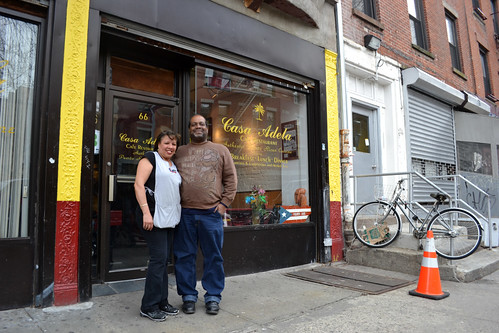 Michelle Rick
Michelle RickGood morning, East Village.
Welcome to the weekend, that is, unless you started things early with Cinco de Mayo celebrations last night. East Village bars, restaurants, and even delis got into the festivities.
Keep out those calendars out for some more memorable dates; Sunday is Mother’s Day, and for all you naughty children who forgot to make plans, DNAinfo put together a nice list of “outside the box” ideas, like East Village and NoHo History and Dessert Tour at Twilight.
For Yiddishe Mamas, perhaps a walking tour chronicling the “beloved balabustas” of the Lower East Side and sharing rugelach with the Eldridge Museum? While you jot down your plans, make note of the the annual Ukrainian festival coming up next weekend and spanning Seventh Street between Second and Third Avenue.
And in other neighborhood news, it seems the much loved ping pong table in Tompkins Square Park has been “defaced, kind of,” according to EVGrieve, despite its graffiti-resilient design of polished steel.
It’s been bad luck lately for the neighborhood’s outdoor sports fixtures: Grieve also reports that the basketball hoop on Extra Place has been removed; the why remains to be seen.
Today’s sunny high of 69 will make a quick dip for rain tomorrow, then back to the high 60’s and sunny skies on Sunday.
 Ian Duncan Luis Rivera and Maritza Lopez outside their Puerto Rican restaurant on Loisaida Avenue. For the first time in 30 years, the area east of Avenue B is less than half Hispanic.
Ian Duncan Luis Rivera and Maritza Lopez outside their Puerto Rican restaurant on Loisaida Avenue. For the first time in 30 years, the area east of Avenue B is less than half Hispanic.The 2010 Census offers a portrait of an East Village that is more populous and less diverse. For the first time since the 1980’s, the area east of Avenue B is less than half Hispanic and the number of white residents in the area has surged.
The total population of the East Village now stands at 73,676, according to the figures, up 5.7 percent over the decade. White people now make up more than half of the population of the neighborhood, while Hispanics make up less than one quarter. The number of blacks in the neighborhood dipped by 5 percent.
East of Avenue B — the census splits records down that street — the trend is even more dramatic. The Hispanic population there fell by a little more than 10 percent, while the white population in that part of the neighborhood jumped almost 38 percent.
Claudio Remeseira, founder and director of the Hispanic New York Project at Columbia University, said the trend illustrates a number of changes taking place to the neighborhood, including gentrification, the upward mobility of some Puerto Ricans, and the decision of others to leave the city entirely.
“We are used to talking about poverty,” Mr. Remeseira added, “we tend to forget there is also upward mobility of Puerto Ricans and Domicans.”
Read more…





